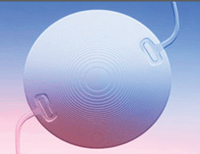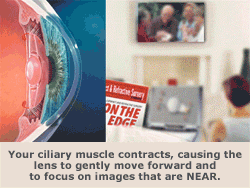Replacement Lens Options
Once your doctor removes your old lens, a new lens is gently placed into your eye. With technology and advances in medicine, there are now many different types of lenses to choose from. With the right lens, you may greatly improve your vision and reduce your dependency on glasses. In fact, many of our patients are able to see as well as they did during their youth. At your cataract consultation, you and your doctor will discuss your lens option in detail so you can choose the right one for your lifestyle and vision goals.
Please watch this video to learn about the different lenses we offer at Pacific Eye Associates.
Monofocal Lens
Monofocal Lens (IOL): These IOLs have one point of clear focus. The one point of focus will usually give you clear distance vision, but you will need glasses for near and intermediate vision.
Multifocal Lens
Multifocal Lens (IOL): These lenses will have more than one point of focus. Multifocal lenses may correct near, far and in-between vision, which will lead to less dependency on glasses. There are many different types of multifocal lens. Depending on your eyes, eyesight and your vision outcome, one of the following multifocal lens below will be fitting into your eye.

- Bifocal Diffractive IOLs
Bifocal diffractive IOLs provide two distinct images at a near and far point. The center of a bifocal diffractive lens is surrounded by tiny concentric rings. These tiny concentric rings will decrease in height, which will result in the diffraction of light at both distance and near. Bifocal diffractive lenses are similar to contact lenses because near and far add powers are available through the bifocal lens depending on your vision. - Refractive IOLs
Refractive IOLs are lenses that have multiple focal points that allow for viewing at all distances. The progressive silicone IOL consists of five concentric zones alternating between distance- and near- viewpoint. In addition to the first generation, there is a second-generation refractive IOL available, that enhanced some aspects of the distance and near viewpoints, such as enlargement of certain parts your vision so that visual disturbances could be reduced.
Other Types of Lenses
Extended Depth of Focus Lens (IOLs): Extended depth of focus (EDF) IOLs are a newer category of lenses that aims to create a single elongated focal point to enhance a range of vision. Intermediate vision is improved compared to standard bifocal multifocal IOLs, but near vision may only be modestly improved. While EDF IOLs sounds like the easy choice because of the elongated focal point, this lens option is not for everyone. Many people may experience a unique visual phenomenon typically described as “starbursts.”
 Accommodative IOLs: An accommodative IOL will flex and bend with you muscle of the eyes. The lens will gently move forward to focus on images that are near, and then bend to focus on images that are near to intermediate. Patients may still require reading glasses for near vision.
Accommodative IOLs: An accommodative IOL will flex and bend with you muscle of the eyes. The lens will gently move forward to focus on images that are near, and then bend to focus on images that are near to intermediate. Patients may still require reading glasses for near vision.
Imagine being able to read your smartphone or tablet, drive at night or play golf all without worrying about glasses. Like we mentioned before, cataract surgery is actually quite an exciting procedure. With so many different lenses to choose from precise vision is at your fingertips at Pacific Eye Associates. Take our IOL test to discover which IOL may be right for you.


